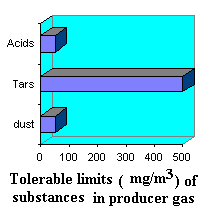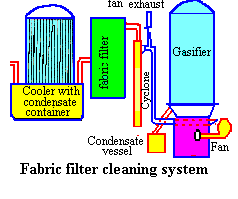 Producer gas leaves the gasifier as the mixture of combustible and non-cobustible gases alongwith
tar vapour, water vapour, dust, mineral vapour. Sulphur compounds such as hydrogen sulphide (H 2 S) and nitrogen compounds (NH 3 , HCN) in producer gas are undesirable as their condensates are corrosive and pollutants in exhuast gases. The generation of H 2 S is of little importance in gasification of biomass as long as sulphur contnet does not exceed 0.5%. The amount of NH 3 and HCN in the gas depends on the nitrogen content of the fuel. Fuel with nitrogen content less than 2 % is safe for gasification. Silicon oxide (SiO 2 ) and iron oxide (Fe 2 O 3 ) in dust are important because of their abrasive nature.
Producer gas leaves the gasifier as the mixture of combustible and non-cobustible gases alongwith
tar vapour, water vapour, dust, mineral vapour. Sulphur compounds such as hydrogen sulphide (H 2 S) and nitrogen compounds (NH 3 , HCN) in producer gas are undesirable as their condensates are corrosive and pollutants in exhuast gases. The generation of H 2 S is of little importance in gasification of biomass as long as sulphur contnet does not exceed 0.5%. The amount of NH 3 and HCN in the gas depends on the nitrogen content of the fuel. Fuel with nitrogen content less than 2 % is safe for gasification. Silicon oxide (SiO 2 ) and iron oxide (Fe 2 O 3 ) in dust are important because of their abrasive nature.
 For trouble free operation, engine must be supplied with producer gas that is sufficiently free from tars, dust and acids. The cleaning of gas is necessary to avoid wear and tear in engine. Dust concentration in the gas depends upon the type of gasifier, intensity of load and type of fuel. As load increases, dust concentration in producer gas also increases. The removal of tar from gas producer is one of the more difficult problmes in gas cleaning.
For trouble free operation, engine must be supplied with producer gas that is sufficiently free from tars, dust and acids. The cleaning of gas is necessary to avoid wear and tear in engine. Dust concentration in the gas depends upon the type of gasifier, intensity of load and type of fuel. As load increases, dust concentration in producer gas also increases. The removal of tar from gas producer is one of the more difficult problmes in gas cleaning.

Gas cleaning and cooling for gasifier system is accomplished by a cyclone, a gas cooler with some scrubbing action and a packed bed filter. Gas cooling increases density of gas in order to maximize the amount of gas entering the engine cylinder. Wet scrubbers are used to remove gaseous pollutants and solid particles while cooling the gas at same time. There exists different kinds of scrubbers for small scale producer engine system. A Packing bed scrubber consists of packing, liquid, support grates and distributors plates. Packing can be made from wide range of commercial and home made materials-steel, wool, wood chips, coke, gravel etc. Gas is passed through bottom and removed at top.
 Fabric filter is considered to be one of the suitable filters for vehicle application. It is placed immediately after cyclone . In filter with glass-fibre cloth, it is possible to withstand a gas temperatue upto 300 o c. The performance of filter depneds on type of gasifier, fuel moisture content and how vehicle is driven. It is recommended that gas flow rate throught filter box shall not exceed 65 m3/h. Pressure loss over filter is affected by load and amount of dust in the producer gas.
Fabric filter is considered to be one of the suitable filters for vehicle application. It is placed immediately after cyclone . In filter with glass-fibre cloth, it is possible to withstand a gas temperatue upto 300 o c. The performance of filter depneds on type of gasifier, fuel moisture content and how vehicle is driven. It is recommended that gas flow rate throught filter box shall not exceed 65 m3/h. Pressure loss over filter is affected by load and amount of dust in the producer gas.To retun to main page click here
This page is developed and maintened by :
Chandrakant Turare ,
ARTES Institute,
University of Flensburg
Flensburg, Germany
Email: chand@uni-flensburg.de